| Journal of Endocrinology and Metabolism, ISSN 1923-2861 print, 1923-287X online, Open Access |
| Article copyright, the authors; Journal compilation copyright, J Endocrinol Metab and Elmer Press Inc |
| Journal website https://jem.elmerpub.com |
Review
Volume 15, Number 2, April 2025, pages 45-57
Research Hotspots and Trends in the Immune Microenvironment of Papillary Thyroid Cancer: A Visual Analysis of the Literature
Jia Feng Lia, Mu Ge Liua, Xiong Sheng Xiaoa, b
aDepartment of Vascular and Thyroid Surgery, Affiliated Hospital of Guangdong Medical University, Zhanjiang City, Guangdong Province, China
bCorresponding Author: Xiong Sheng Xiao, Department of Vascular and Thyroid Surgery, Affiliated Hospital of Guangdong Medical University, Zhanjiang City, Guangdong Province, China
Manuscript submitted March 6, 2025, accepted April 5, 2025, published online April 22, 2025
Short title: Immune Microenvironment of PTC
doi: https://doi.org/10.14740/jem1508
| Abstract | ▴Top |
Papillary thyroid carcinoma (PTC) is the most common type of thyroid cancer and one of the major diseases of endocrine malignancies worldwide. Its occurrence and progression are closely related to complex immune mechanisms, especially the dynamic changes of the tumor immune microenvironment. With the deepening of research, the interaction between PTC and the immune microenvironment has become a research focus in this field. In order to systematically evaluate the development trend of this field, this study used bibliometric methods to screen 180 relevant documents as of November 23, 2024 based on the Web of Science Core Collection (WOSCC) database, and used Bibliometrix R package and Citespace for data analysis and visualization. The analysis results showed that China and the United States were the main contributors to this field. Frontiers in Endocrinology was the journal with the highest number of publications, followed by Endocrine-Related Cancer and Frontiers in Immunology. In terms of authors, ZHANG W ranked first with seven articles, and LI X and WANG Y were the main contributors. Keyword analysis showed that “long noncoding RNAs” and “immune microenvironment” were the core themes of the research. Through bibliometric analysis in the field of PTC immune microenvironment, this study revealed the research hotspots, core countries, institutions, authors, and journals, clarified the direction and development trend of future research, and provided important academic reference for further exploration of PTC immune mechanisms and their clinical applications.
Keywords: Papillary thyroid cancer; Immune microenvironment; Bibliometrics; Visual analysis; Frontier
| Introduction | ▴Top |
Papillary thyroid carcinoma (PTC) is the most common thyroid malignancy, accounting for more than 80% of thyroid cancers, and its incidence has continued to rise in recent years [1-3]. Although PTC generally has a good prognosis and can achieve a high cure rate through surgical treatment, some patients still face clinical challenges such as tumor recurrence [4], drug resistance, and metastasis. In particular, the treatment effect is significantly limited in certain high-risk patients. Studies have shown that the occurrence of these clinical problems is closely related to the immune microenvironment of the tumor, and changes in the immune microenvironment may be an important factor affecting the treatment effect and prognosis of PTC [5].
The tumor immune microenvironment (TME) refers to the complex cellular and molecular environment surrounding tumor cells, including infiltrating immune cells, blood vessels, extracellular matrix (ECM), and secreted cytokines and chemical factors. This environment not only directly affects the occurrence and development of tumors, but also plays an important role in the tumor’s response to treatment [6, 7]. Immune cells in the immune microenvironment, such as tumor-infiltrating lymphocytes (TILs) [8], tumor-associated macrophages (TAMs) [9], dendritic cells (DCs) [10], and their interactions with tumor cells have an important impact on tumor immune escape, drug resistance, and metastasis. The immune microenvironment is not only reflected in the interaction between immune cells and tumor cells, but also includes the functional state of immune cells, the activation of immune escape mechanisms [11], and changes in cytokines and chemical factors [12]. In addition, the role of non-immune cell components such as cancer-associated fibroblasts (CAFs) [13] and vascular endothelial cells [14] cannot be ignored. The active participation of these cells in the TME further promotes the malignant progression of tumors.
In recent years, more and more studies have revealed the key role of the immune microenvironment in tumor immune escape, drug resistance, and metastasis. In PTC, tumor immune escape is usually manifested as a dual function of immune cells. On the one hand, immune cells help tumors escape the host’s immune surveillance by secreting immunosuppressive factors or inhibiting immune responses; on the other hand, certain cells in the immune microenvironment, especially TAMs, may also support the continued development of tumors by promoting tumor growth and metastasis [11, 15]. The functional status of TILs is also crucial to the immune escape and treatment response of PTC. Studies have shown that the number, subpopulation distribution, and activity of TILs in the TME may be important factors in determining tumor immune escape and drug resistance [16]. Therefore, in-depth research on the functions and interactions of different cell populations in the immune microenvironment will help us better understand the immune escape mechanism of PTC and provide a theoretical basis for the development of new treatment strategies.
In order to more comprehensively understand the current status of research on the immune microenvironment of PTC and evaluate its role in tumor immune escape, drug resistance, and metastasis, this paper will systematically sort out and analyze the relevant publications, institutions, authors, and keywords of the immune microenvironment of PTC through bibliometric analysis, so as to provide theoretical basis and research direction for subsequent research.
Bibliometrics evaluates the generation, dissemination, and impact of scientific research literature through quantitative and statistical analysis methods, mainly involving the collection and organization of bibliographic data [17]. This method is widely used to identify the influence of research results, evaluate scientific research productivity, track academic dissemination and changes in its impact, and reveal scientific research trends and interdisciplinary cooperation, providing a basis for resource allocation and strategic decision-making of scientific research institutions [18]. With the increase in research literature on the immune microenvironment of PTC, bibliometrics will provide continuous support for the development direction and academic influence of this field.
This study evaluated the current understanding of the immune microenvironment of PTC through bibliometric analysis, revealing the research trends and shortcomings in this field. Existing studies have shown that the immune microenvironment plays an important role in tumor immune escape, treatment response, and drug resistance. In particular, immune cell infiltration and cytokine expression have a profound impact on tumor biological behavior. Although regulating the immune microenvironment has the potential to improve treatment efficacy, existing literature emphasizes that in-depth exploration of the mechanism of action of the immune microenvironment in PTC is still key. By integrating existing results, this study aims to fill the gap in the literature, provide researchers, clinicians, and policy makers with the latest theoretical overview, and provide a scientific basis for future optimization of treatment strategies, clinical practice, and public health policies.
| Methods | ▴Top |
Data collection
This study used the Web of Science Core Collection (WOSCC) as the data source to ensure comprehensive and accurate retrieval. The selected index databases were SCI-EXPANDED and SSCI. To minimize bias from database updates, all data were exported on November 11, 2024. The search covered the period from January 1, 2010, to November 23, 2024, and was limited to English-language original articles and reviews. The search strategy was: (TS = (papillary thyroid carcinoma OR thyroid papillary carcinoma OR thyroid carcinoma, papillary OR papillary thyroid cancer OR thyroid papillary cancer OR thyroid cancer, papillary) AND TS = (immune microenvironment)) AND LA = (English). A total of 180 relevant publications were identified, including 151 original research articles and 29 reviews. Web of Science was chosen as the primary database because it indexes over 12,000 academic journals worldwide and offers robust and reliable tools for bibliometric analysis [19].
Data analysis
Bibliometric analysis was performed using R (v4.0.17) [20], Tableau [21], CiteSpace [22], and Excel. Author publication counts were calculated with the Bibliometrix R package [23]. Tableau was used to generate national publication maps, while CiteSpace was applied to visualize international collaboration networks, journal dual maps, and institutional co-occurrence networks. Keyword co-occurrence networks, burst term maps, and thematic clusters were also constructed using CiteSpace. Publication trends were analyzed using an exponential growth model in Excel [24].
| Results | ▴Top |
Publication status
As shown in Figure 1, this study included 180 documents, of which 151 were research articles (accounting for 83.9%) and 29 were reviews (accounting for 16.1%). Figure 2 shows the annual number of publications and the cumulative number of publications related to the immune microenvironment of PTC. It gradually increased from two articles in 2010 to eight articles in 2015. Then in the next 9 years, the number of articles published increased significantly, and by 2024, the cumulative number of articles published reached 180. Using an exponential growth function analysis, there was a significant correlation between the number of publications and year (R2 = 0.9848), indicating that the field has experienced rapid growth and development in recent years.
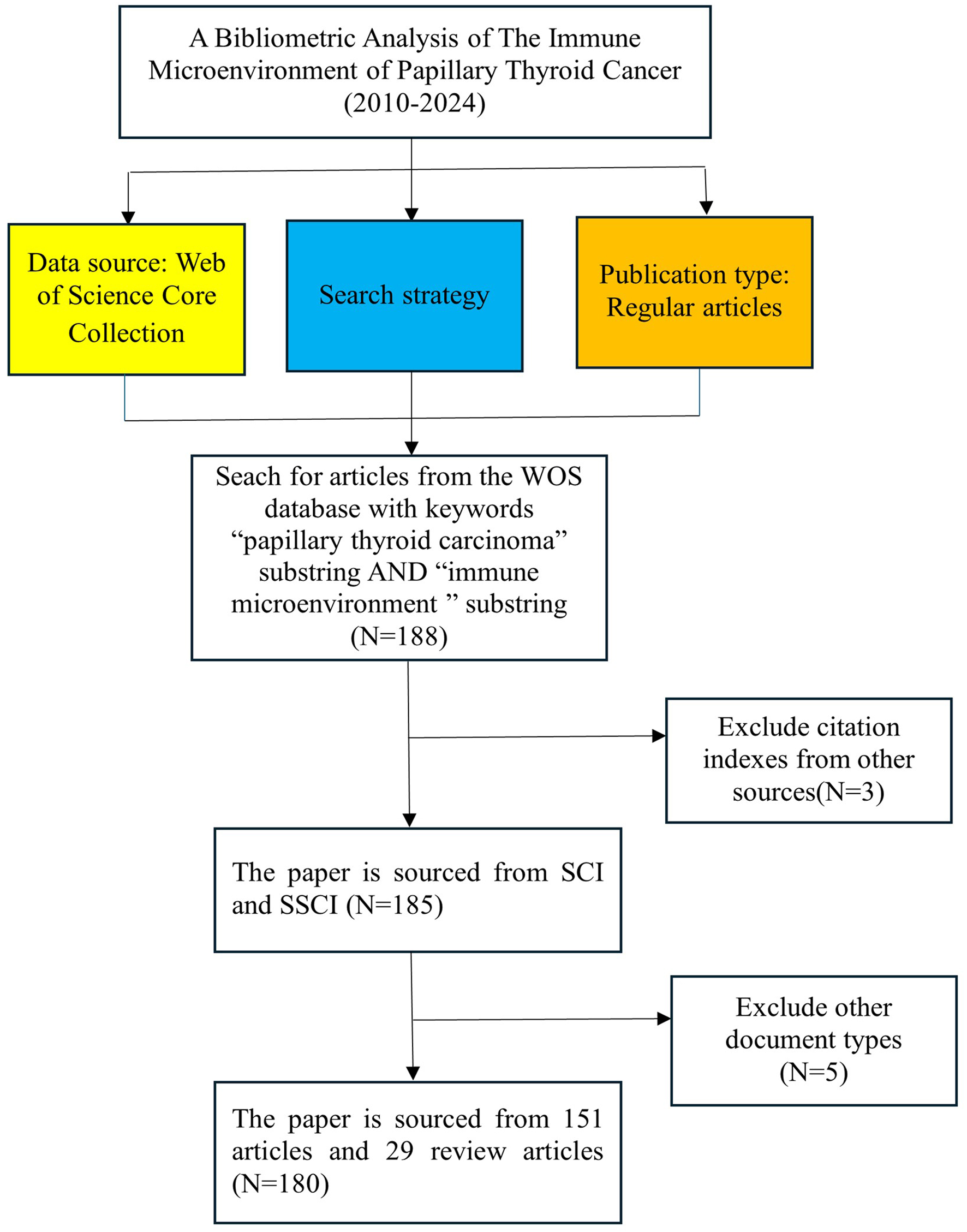 Click for large image | Figure 1. Flowchart of the study. |
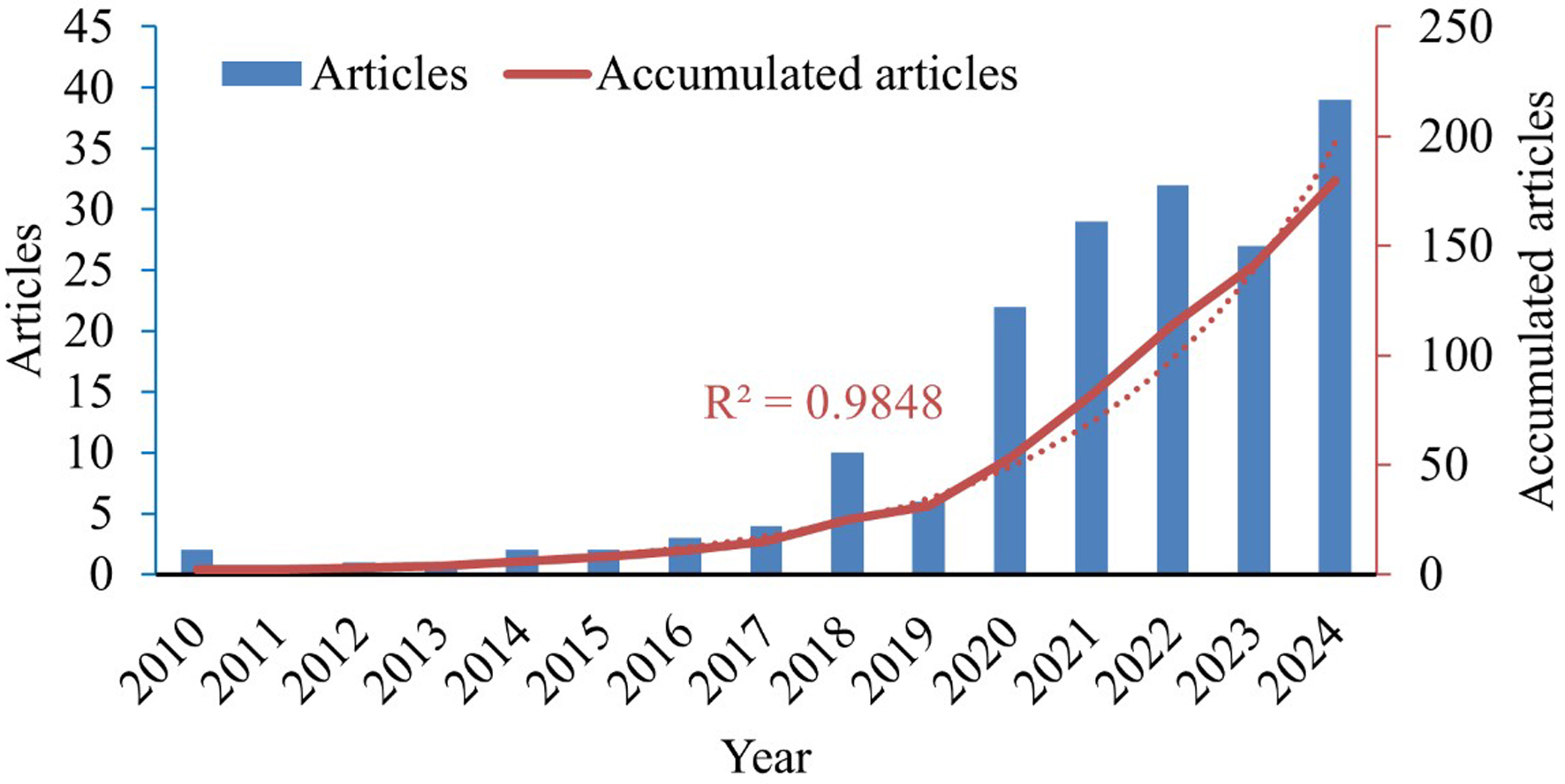 Click for large image | Figure 2. Number of publications per year and the cumulative number. |
Country/region publications analysis
This study analyzed the number of national publications in the field of immune microenvironment in PTC. The results show that China ranks first with 105 articles, followed by the United States (27 articles), Italy (21 articles), South Korea (11 articles), Japan (nine articles), and Brazil (six articles). The number of articles published by other countries is low (n = 5) (Fig. 3a).
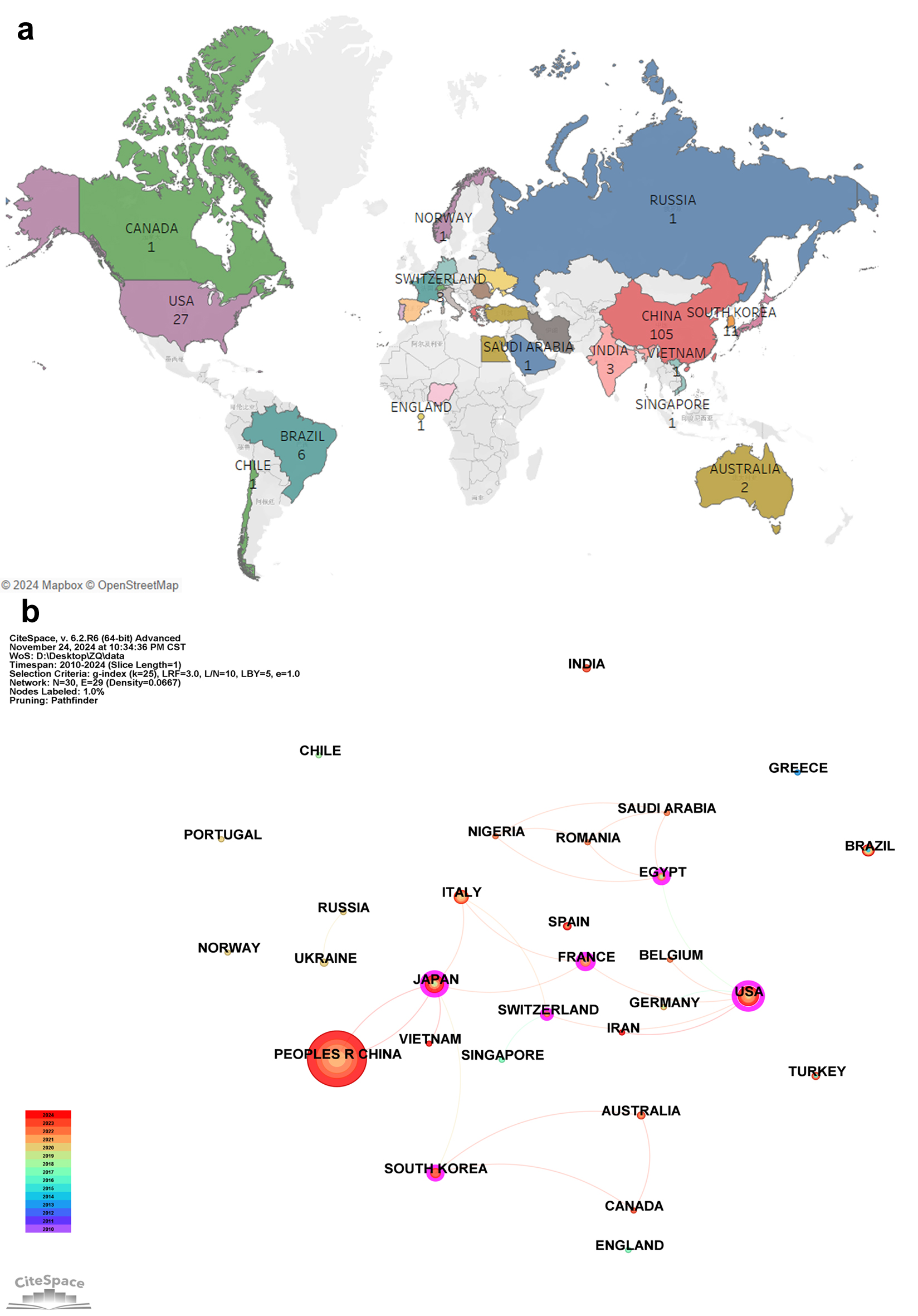 Click for large image | Figure 3. (a) Each country’s contribution to the immune microenvironment. (b) Mapping of cooperation networks between countries (regions). |
Figure 3b shows the structure of the international academic collaboration network from 2010 to 2024. The United States occupies a core position in this network and exhibits extensive international cooperation, especially with close ties with European countries such as Germany, the United Kingdom, and France. Although China’s nodes are large, indicating its growing influence in the academic field, its cooperative links with other countries are relatively limited, mainly concentrated in a few countries such as Japan, Singapore, and the United States. Other important nodes, such as Japan, Germany, and the United Kingdom, also show stable cooperative relationships.
Judging from the time evolution trend, China’s nodes are gradually turning red, indicating that its activity in international cooperation has significantly increased. However, compared with the United States, although China’s academic influence continues to increase, the scope and frequency of its international cooperation are still relatively limited. The United States not only occupies a central position in the cooperation network, but also maintains close and extensive cooperation with many European countries. Some emerging countries (such as Egypt, Saudi Arabia, etc.) have low participation in international cooperation, indicating that their cooperation networks are still in the development stage. Generally speaking, the international cooperation pattern dominated by the United States is gradually emerging, and China is strengthening its participation in global academic exchanges.
Analysis of institutional publications
As shown in Figure 4, the node size represents the amounts of articles published by the organization, the connection reflects the intensity of cooperation, and the color from blue (early) to yellow (recent) shows the time evolution trend. Tianjin Medical University, China Medical University, Fudan University, and Harvard University are the core nodes, highlighting their high volume of publications and extensive cooperation network in the research field. Tianjin Medical University occupies a key position in domestic and international cooperation, while China Medical University demonstrates its academic contributions through a more independent research network.
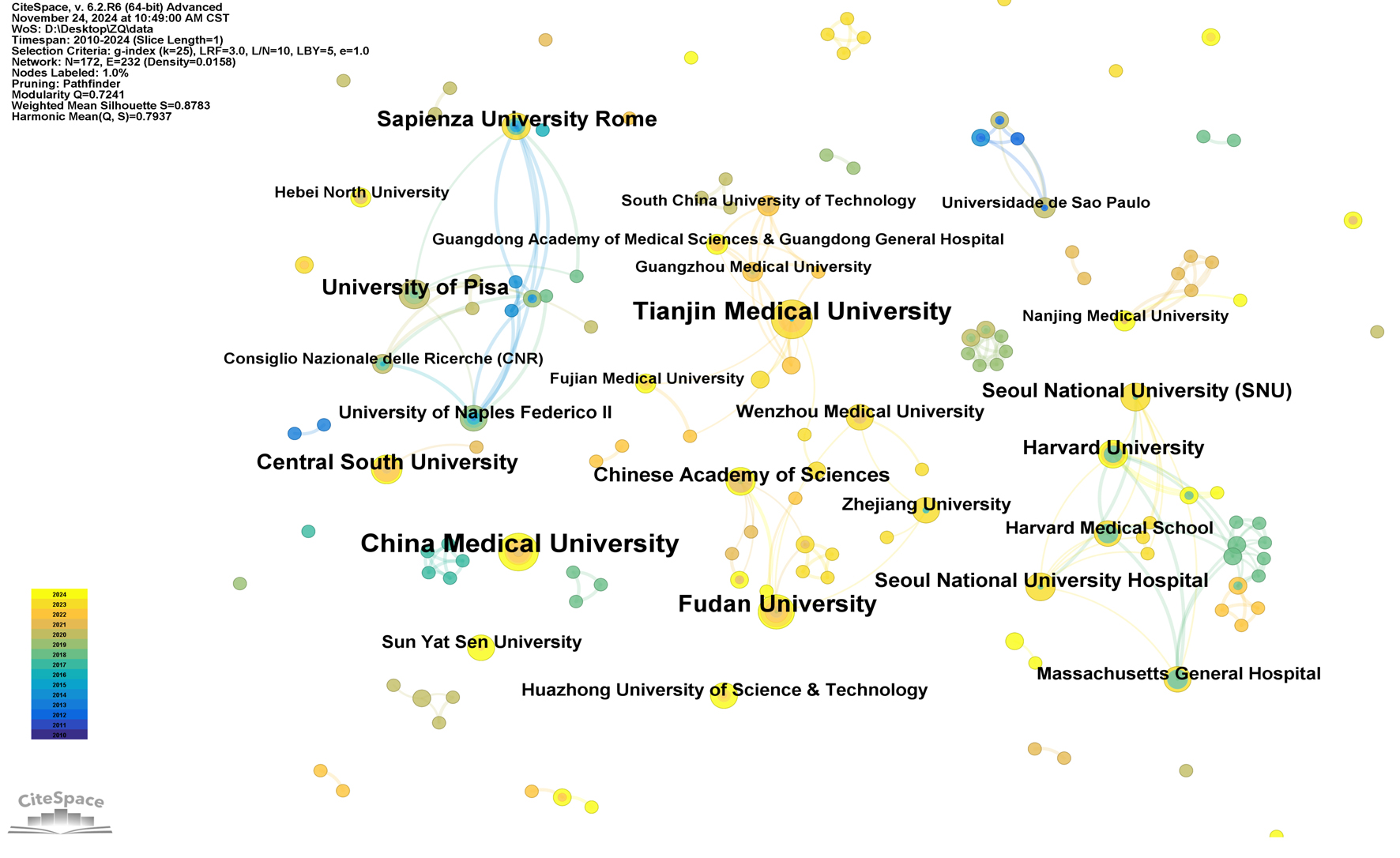 Click for large image | Figure 4. Mechanism co-occurrence of the immune microenvironment. |
The network analysis results show that higher modularity (Q = 0.7241) and silhouette coefficient (S = 0.8783) indicate that the network has a clear modular structure and significant clustering effect. There is close cooperation within the module and strong independence between modules. The time evolution trend shows that in recent years, domestic institutions such as Tianjin Medical University have gradually become more active in international cooperation, reflecting the increase in their academic influence. At the same time, Harvard University and its affiliated institutions (such as Massachusetts General Hospital and Harvard Medical School) have formed a dense cooperation network with other universities, emphasizing the important role of international academic exchanges in promoting the development of research fields. This figure reveals the cooperation model and time evolution trend of core institutions, providing an important reference for future academic cooperation and research directions.
Journal analysis
Journal double chart analysis
The journal dual chart shows the knowledge flow pattern between citing journals and cited journals. The left side shows the cluster of citing journals, the right side shows the cluster of cited journals, and the citation curve in the middle shows the direction of knowledge flow. The longer the vertical axis of the ellipse, the more papers the journal publishes, and the longer the horizontal axis, the more authors there are. Analysis shows that the citation path is mainly divided into green and yellow paths: citing journals are mainly concentrated in the fields of molecular biology, immunology, and clinical medicine, while cited journals are concentrated in the fields of molecular biology and genetics. The green path shows that basic life sciences such as immunology provide key theoretical support for genetic research; the yellow path reveals the practical application of clinical medicine research in genetic research. Overall, it reflects the close collaboration between basic and applied research in the field of life sciences, as well as the characteristics of interdisciplinary knowledge flow, and provides an important reference for research trends and academic cooperation models (Fig. 5).
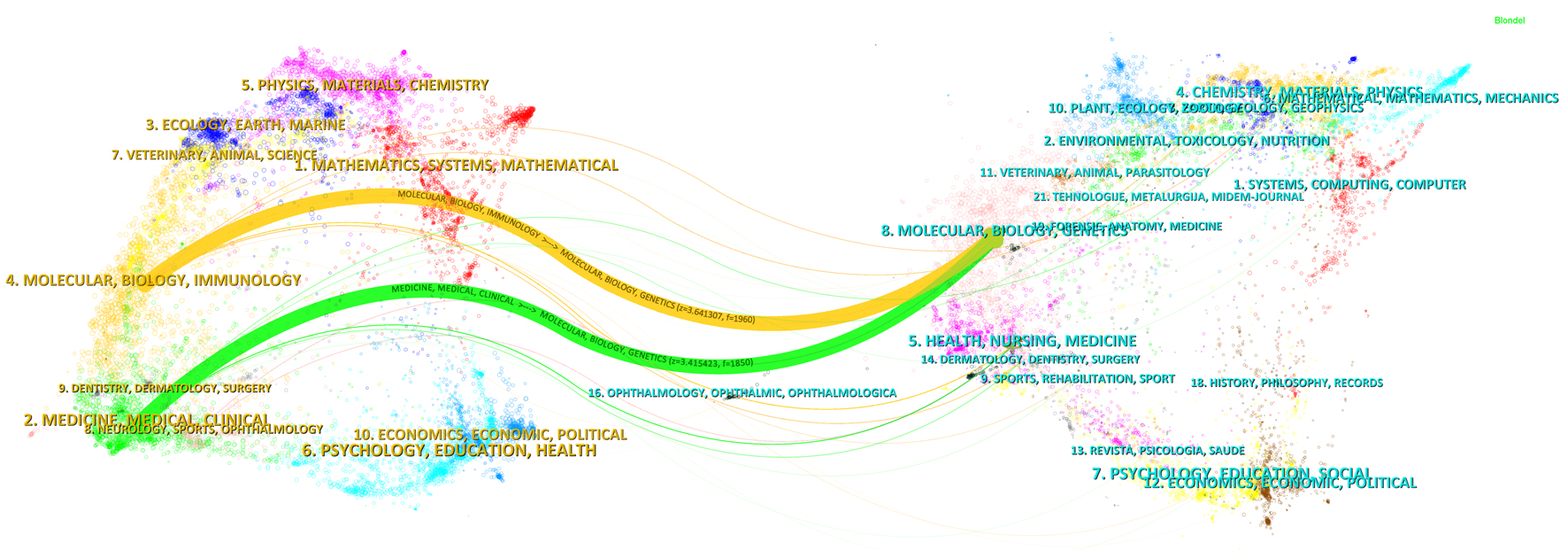 Click for large image | Figure 5. Double graph overlay analysis of citing and cited journals. |
Analysis of publication quantity and journal impact
Table 1 shows the number of articles, impact factors (IF) [25], and JCR [26] divisions of core journals, revealing research hotspots and major journals for submission. Frontiers in Endocrinology ranks first with 15 articles (IF = 3.9, Q2 division), highlighting the key position of endocrinology in this field. Endocrine-Related Cancer, Frontiers in Immunology, and Frontiers in Oncology published eight articles each, among which Frontiers in Immunology had the highest IF (5.7, Q1 division), showing the importance of research in immunology and oncology. Cancers and Frontiers in Cell and Developmental Biology published six articles each, and the IFs were both over 4.5 (Q1 division), emphasizing the academic influence of oncology and cell biology. Overall, most journals are in the Q1 and Q2 divisions (such as Journal of Clinical Endocrinology & Metabolism and International Journal of Molecular Sciences), reflecting that research is concentrated in high-quality journals, highlighting the frontier development of interdisciplinary disciplines such as endocrinology, oncology, immunology, and molecular sciences.
 Click to view | Table 1. Top 10 Journals in the Field of Immune Microenvironment |
Author impact analysis
Authors’ overall productivity
Table 2 presents the main descriptive variables related to the number of authors of studies related to PTC and the immune microenvironment before publication. The total output related to this topic includes contributions from 1,203 authors, with an average of 14.96% of publications per author. Only one author (0.08%) published a single paper, while 16.11% of the authors engaged in international collaborations, with an average of 8.22 authors per paper.
 Click to view | Table 2. Authors’ Main Descriptive Variables |
Authorial publication volume
The publication volume of authors in this research area was analyzed using multiple metrics, including the number of publications, author dominance ranking, and co-citation analysis. Table 3 lists the publication volume of different authors that make up the research sample in this area. This includes the first author, the last author, and other positions in the author ranking. The author with the highest publication volume is ZHANG W with seven articles, followed by LI X, WANG Y, ZHANG J, and ZHANG Y. This analysis provides insights into the prolific contributors to the discourse on PTC and the immune microenvironment.
 Click to view | Table 3. Number of Articles by the Top Authors |
Keyword analysis
Keyword cluster analysis
This study classified the research topics through cluster analysis, and the results showed that the cluster structure was significant (Q = 0.7241, S = 0.8783). Figure 6a shows 16 clusters, revealing core research directions. #0 Immunity and #1 Papillary Thyroid Carcinoma are the clusters with the largest number of keywords, focusing on immune mechanisms and thyroid cancer pathology, indicating the core position of immunology in cancer research. #8 Immune Infiltration and #4 Tumor Immune-Microenvironment focus on the study of immune microenvironment mechanisms, highlighting the interaction between immunity and tumor microenvironment. #7 PD-L1 and #10 Inflammation focus on the interaction of immune checkpoint inhibition and inflammatory mechanisms. #11 Anaplastic Thyroid Cancer and #14 Disease-Free Survival focus on aggressive cancer treatment and patient prognosis. #12 Mitochondrial Transfer and #6 Activation in the basic research direction reveal further exploration of molecular mechanisms. Overall, the cluster analysis shows the multi-level pattern of thyroid cancer research from basic mechanisms to clinical treatment, especially in aspects such as immune mechanism, TME, and treatment effect. It reflects the intersection of disciplines and application extension, and provides a basis for future immune regulation. In-depth research on precision medicine and personalized treatment guides the direction.
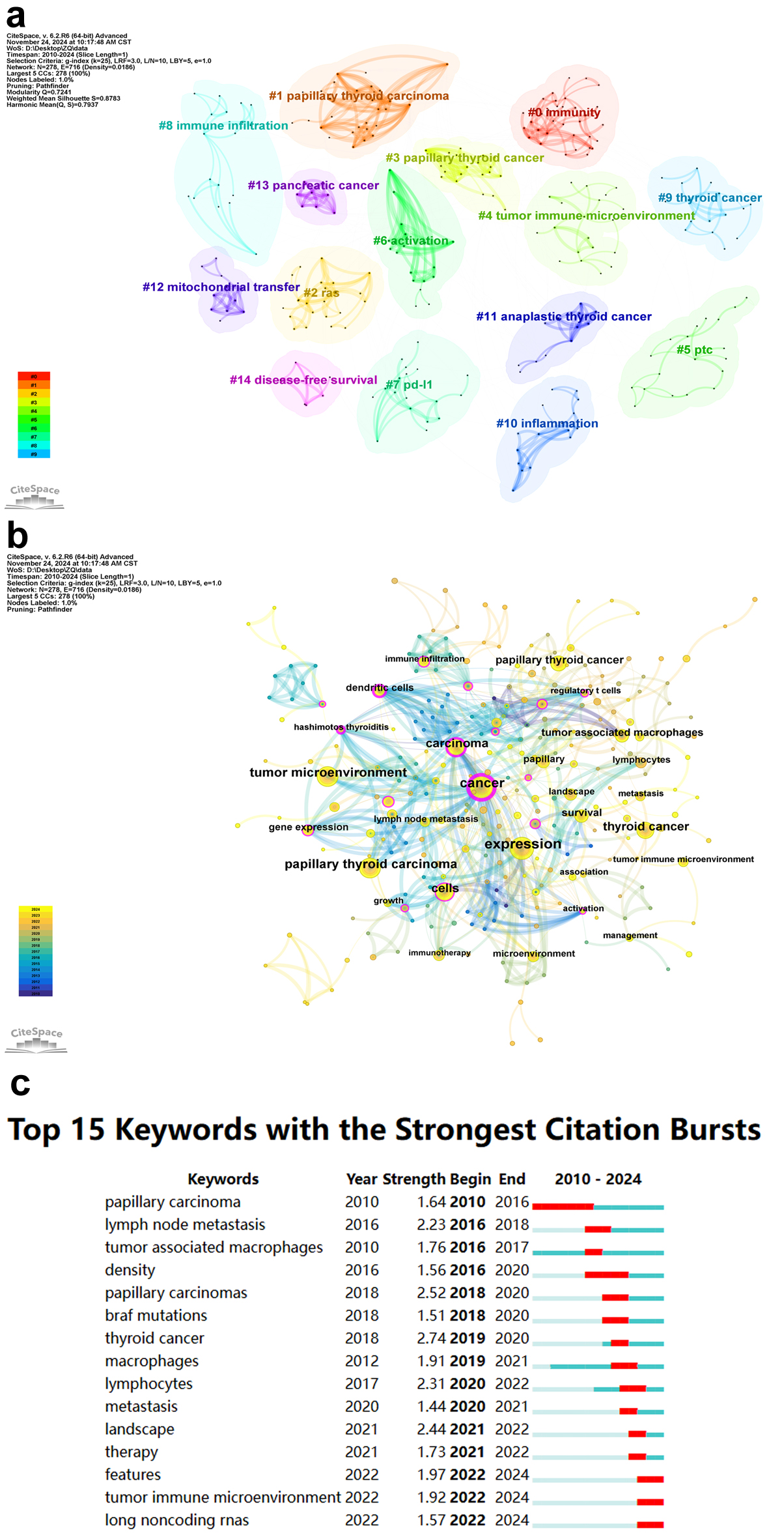 Click for large image | Figure 6. (a) Keyword clustering diagram of the immune microenvironment. (b) Keyword co-occurrence diagram of the immune microenvironment. (c) Keyword emergences of the immune microenvironment. |
Keyword co-occurrence analysis
Figure 6b shows the co-occurrence relationship and time evolution trend of keywords with a frequency greater than 9 in the field of thyroid cancer. Core keywords such as “cancer”, “carcinoma”, and “tumor microenvironment” have the largest nodes and the densest connections, reflecting their core position in the field. Related keywords such as “immune infiltration”, “gene expression”, and “tumor immune microenvironment” form a close research network, reflecting the widespread attention paid to immunology and gene mechanisms.
In recent years, immunotherapy and tumor microenvironment have become research hotspots. The figure shows that “papillary thyroid carcinoma” is closely related to “lymph node metastasis”, emphasizing the focus of this field on pathological mechanisms and metastasis research. At the same time, “tumor associated macrophages” and “regulatory T cells” reflect the importance of immune microenvironment. Judging from the time evolution trend in the figure (color from blue to yellow), keywords such as “immune infiltration” and “tumor immune microenvironment” belong to the newer period, indicating that research in recent years has gradually focused on the interaction mechanism between the immune system and tumors. This trend indicates that research is gradually shifting from traditional tumor treatment to precise exploration of the immune microenvironment, promoting the translation of molecular mechanisms into personalized treatments.
Keyword burst analysis
Figure 6c shows the 15 strongest keywords in Citation Bursts in the field of thyroid cancer from 2010 to 2024, reflecting the dynamic changes in research hotspots. Early keywords such as “papillary carcinoma” and “tumor associated macrophages” show that basic research focuses on disease classification and immune mechanisms. As time goes by, research gradually deepens into the interaction between TME and immune mechanisms.
In recent years, “tumor immune microenvironment” and “long noncoding RNAs” have become new research hotspots, with burst times concentrated in 2022 - 2024, reflecting the importance of immune microenvironment mechanisms and gene regulation. In addition, the emergence of keywords such as “therapy” and “features” shows that research is gradually shifting to precision treatment and disease feature identification. The overall trend shows that research is shifting from basic pathology and immune mechanisms to TME, gene regulation, and treatment strategies, promoting the development of personalized diagnosis and treatment and precision medicine.
| Discussion | ▴Top |
In recent years, the research on PTC has been continuously deepened, and immune-related mechanisms have especially gradually become the focus of research in this field [6, 27-28]. This article uses bibliometric methods to systematically sort out the development trends of PTC research from 2010 to 2024, revealing that the academic community is gradually turning its attention to precision medicine from basic exploration of pathological characteristics and molecular mechanisms of this research. From the early research on cellular and molecular mechanisms [29] to the widespread application of immunotherapy [30] today, the research direction of the academic community has changed significantly, especially immune checkpoint inhibitors (ICIs) [31, 32]. The potential and challenges of immunotherapy in PTC have gradually become the focus of research. This transformation not only reflects the revolutionary impact of immunotherapy on tumor treatment, but also highlights the core role of precision medicine in improving treatment effects and patient prognosis.
According to bibliometric analysis, from 2010 to 2015, the keywords of PTC research were mainly concentrated in basic research fields such as “gene mutation” [32] and “cell signaling pathway” [33, 34]. The number of research literature is increasing year by year, but there are relatively few studies related to immune mechanisms. Since 2016, with the rise of immunotherapy, especially the widespread application of ICIs, immune mechanisms have gradually become the core of research, and the number of relevant literatures has increased significantly. Through keyword frequency analysis, we found that “immune microenvironment” [6, 7], “immune escape” [11], and “immune checkpoint” [5, 35] have appeared frequently in recent studies, showing that the important position of immunotherapy in PTC research is revealed.
The immune microenvironment has dual functions in the occurrence and progression of PTC (Fig. 7), and the dynamic balance of its composition profoundly affects tumor behavior [36]. M2 macrophages [37] promote tumor immune escape, angiogenesis, and tumor metastasis by secreting immunosuppressive factors such as interleukin-10 (IL-10) and transforming growth factor-beta (TGF-β) [38, 39]. Regulatory T cells (Tregs) further weaken the function of effector immune cells and promote tumor invasion and metastasis [40]. In contrast, M1 macrophages [41] and T helper cell type 1 (TH1) cells [42] activate anti-tumor immune responses by secreting IL-6 and interferon-gamma (IFN-γ), inhibiting the proliferation of tumor cells [43]. In recent years, research has gradually shifted to the role of these immune cells in the PTC immune microenvironment, especially the key role of M2 macrophages and Tregs in tumor immune escape. Related literature shows that the role of the polarization state of immune cells in tumor progression has become an important research direction in academia [44, 45].
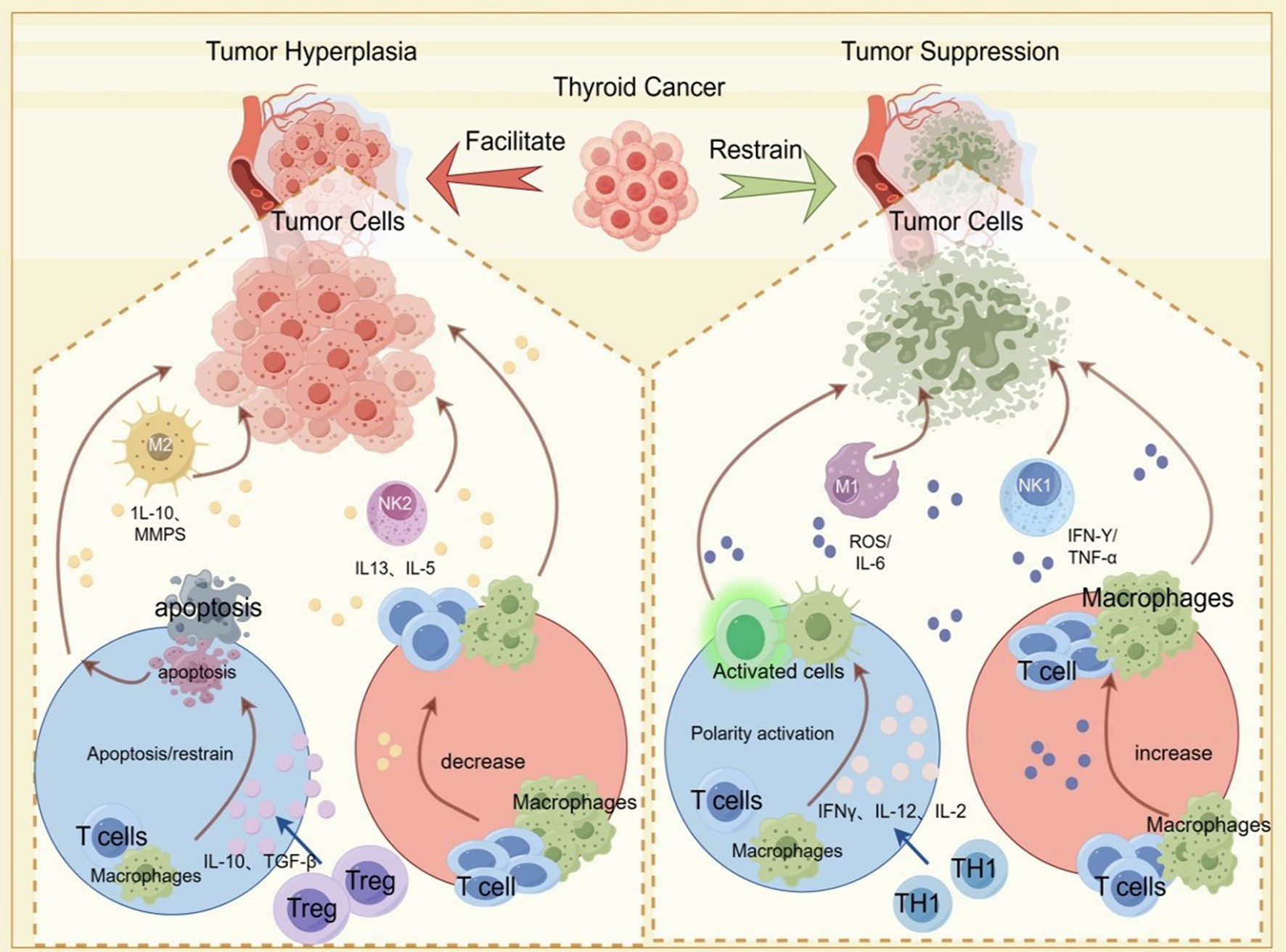 Click for large image | Figure 7. Research progress and current situation. |
With the advancement of immunotherapy research, the application of ICIs in PTC has gradually become the focus of research. Through bibliometric analysis, we found that the number of research documents on ICIs has grown significantly since 2016, especially immunotherapy studies related to v-Raf murine sarcoma viral oncogene homolog B1 (BRAF) mutations [46] or rearranged during transfection/papillary thyroid carcinoma (RET/PTC) fusion [47]. These studies show that the combination of ICIs and targeted therapy can significantly improve the prognosis of PTC patients. The clinical application of ICIs still faces certain challenges, especially how to overcome immune tolerance, improve therapeutic effects, and reduce side effects. Current research focuses on combination regimens of immunotherapy, especially combination strategies with targeted therapies, such as BRAF inhibitors and RET inhibitors, which have shown good efficacy and provided new ideas for immunotherapy of PTC [48, 49].
In addition, the application of ICIs in PTC has not been fully popularized, and there are certain treatment difficulties. Although ICIs can effectively restore the anti-tumor function of T cells, due to the complex immune microenvironment of PTC, including the polarization of immune cells, activation of immune escape mechanisms, and the existence of immune tolerance, these factors may affect the efficacy of ICIs [50, 51]. Therefore, future research must not only further explore the impact of the immune microenvironment on immunotherapy, but also need to conduct in-depth analysis of the specific mechanisms of immune escape to provide more precise strategies for optimizing immunotherapy regimens.
In recent years, rapid progress in tumor immunology has been reshaping the therapeutic landscape of PTC. Among the advances, the BRAF(V600E) mutation has emerged as a critical molecular marker, offering valuable insights for stratified treatment approaches. This mutation, which varies significantly in prevalence across populations, has been linked not only to tumor initiation and progression but also to immunosuppressive features within the TME, such as increased expression of immune checkpoint molecules and higher infiltration of M2-polarized macrophages and regulatory T cells (Tregs) [52-54]. These findings suggest that patients with BRAF(V600E)-positive PTC may be more suitable candidates for immune-based interventions, particularly those tailored to their specific immune context.
While ICIs have demonstrated efficacy in more aggressive thyroid cancer subtypes, such as anaplastic thyroid carcinoma, their role in radioiodine-refractory PTC (RAI-R PTC) remains limited. For instance, a phase I clinical trial evaluating pembrolizumab in programmed cell death-ligand 1 (PD-L1)-positive RAI-R PTC reported an objective response rate (ORR) of only 9%, with a disease control rate (DCR) of 68%, indicating modest efficacy as monotherapy [55]. However, combination therapies involving BRAF inhibitors and ICIs have shown synergistic antitumor effects in the context of BRAF mutations [54, 56], reinforcing the rationale for molecularly guided immunotherapy, especially for tumors with an immunosuppressive phenotype.
Despite these promising strategies, therapeutic responses remain highly heterogeneous. Variability in immune cell populations, functional states, and cytokine distributions within the TME can significantly influence treatment outcomes. In particular, high levels of M2 macrophages or Tregs are often associated with poor responsiveness to ICIs [57, 58]. As a result, single-gene markers like BRAF(V600E) may be insufficient to accurately predict treatment efficacy. In response, integrative multi-omics approaches, incorporating genomics, transcriptomics, and immune profiling, have emerged as powerful tools for identifying predictive biomarkers and defining immune subtypes [59].
Our bibliometric analysis further indicates that since 2018, research on combination immunotherapies has grown by over 20% annually, reflecting increasing interest in this field. In clinical settings, integrating parameters such as BRAF(V600E) status, PD-L1 expression, and immune cell composition may enable the development of multiparametric predictive models to guide patient selection and reduce unnecessary exposure to immune-related adverse events (irAEs).
Of note, research on personalized immunotherapy [60] will become a hotspot in the future. Through the analysis of molecular markers and immune characteristics, customized personalized treatment plans will significantly improve the treatment effect. At the same time, combining multi-omics technologies, such as genomics and transcriptomics, can further reveal the interaction between the immune microenvironment and tumor metabolism and genetic mechanisms, which may also provide new breakthrough points for treatment.
The study of immune mechanisms in PTC is undergoing a significant shift from basic pathological understanding toward precision immunotherapy. Future research should focus on the following key directions: 1) conducting prospective clinical trials to validate the efficacy and safety of combining BRAF inhibitors with ICIs in RAI-R PTC; 2) developing predictive models of treatment response that integrate molecular, immune, and metabolic features; and 3) promoting the standardized clinical implementation of personalized decision-support tools. As the regulatory mechanisms of the TME become increasingly understood, PTC is expected to transition from a conventional “target-oriented” approach to an “immune microenvironment-oriented” precision treatment paradigm, ultimately improving patient outcomes and quality of life.
This study has certain limitations. First, it included only English-language publications indexed in the WOSCC. This limitation in both language and data source may have led to the omission of important research findings from non-English-speaking countries or regions, thereby affecting a comprehensive understanding of the global research landscape in this field. Therefore, future studies should consider incorporating multi-language databases to expand the scope of research and enhance the representativeness of a global perspective. Second, due to the inherent citation delay in academic publishing, some recently published high-quality studies may not have received sufficient attention or citations and thus were not adequately reflected in this analysis. Future research should also regularly update the dataset to ensure that the results remain timely and comprehensive. Despite these limitations, this study provides valuable insights into the developmental trends, research hotspots, and emerging directions in the field of the immune microenvironment of PTC, helping researchers better grasp current progress and identify key areas for future investigation.
Conclusion
In recent years, the study of the immune microenvironment of PTC has received widespread attention. With the increasing number of relevant literatures, it has become a key field in tumor research. Through the analysis of global research trends, it was found that the journal “Frontiers of Endocrinology” has significant influence in this field, and ZHANG W is the most productive researcher in this field. At the same time, the relationship between long non-coding RNA (lncRNA) and the immune microenvironment has become one of the current research hotspots. The research direction has gradually expanded from basic pathological characteristics and immune mechanisms to the translation of TME, gene regulation, and treatment strategies, providing an important reference for personalized treatment and precision medicine. Therefore, a comprehensive understanding of the development dynamics and cutting-edge trends in this field has important academic value and practical significance for scientific researchers and policy makers.
Acknowledgments
The authors would like to express their sincere gratitude to all colleagues at the Department of Vascular and Thyroid Surgery, Affiliated Hospital of Guangdong Medical University, for their valuable support and collaboration throughout the study.
Financial Disclosure
Grant support by Affiliated Hospital of Guangdong Medical University (grant number: LCYJ2021B003). Project: A Randomized, Double-Blind, Placebo-Controlled, Superiority Study on the Combination of Capecitabine Tablets and Vitamin B1 Tablets for Preventing Peripheral Neuropathy Induced by Paclitaxel Chemotherapy in Breast Cancer Patients.
Conflict of Interest
The authors declare that there is no conflict of interest.
Informed Consent
Informed consent was not applicable to this study.
Author Contributions
Jia Feng Li: conception and design; administrative support; provision of study materials or patients; collection and assembly of data; data analysis and interpretation; manuscript writing; final approval of manuscript. Mu Ge Liu: conception and design; data analysis and interpretation; manuscript writing; final approval of manuscript. Xiong Sheng Xiao: conception and design; administrative support; manuscript writing; final approval of manuscript.
Data Availability
The data supporting the findings of this study are available from the corresponding author upon reasonable request.
Abbreviations
BRAF: v-Raf murine sarcoma viral oncogene homolog B1; CAFs: tumor-associated fibroblasts; DCs: dendritic cells; DCR: disease control rate; ICIs: immune checkpoint inhibitors; IFN-γ: interferon-gamma; IL-10: interleukin-10; irAEs: immune-related adverse events; ORR: objective response rate; PD-1: programmed death-1; PD-L1: programmed death-ligand 1; PTC: papillary thyroid carcinoma; RAI-R: radioactive iodine-refractory; RET/PTC: rearranged during transfection/papillary thyroid carcinoma; TGF-β: transforming growth factor-beta; TH1: T helper cell type 1; TILs: tumor-infiltrating lymphocytes; TME: tumor microenvironment; Tregs: regulatory T cells
| References | ▴Top |
- Filetti S, Durante C, Hartl D, Leboulleux S, Locati LD, Newbold K, Papotti MG, et al. Thyroid cancer: ESMO Clinical Practice Guidelines for diagnosis, treatment and follow-updagger. Ann Oncol. 2019;30(12):1856-1883.
doi pubmed - Haugen BR, Alexander EK, Bible KC, Doherty GM, Mandel SJ, Nikiforov YE, Pacini F, et al. 2015 American Thyroid Association Management Guidelines for adult patients with thyroid nodules and differentiated thyroid cancer: the American Thyroid Association Guidelines Task Force on Thyroid Nodules and Differentiated Thyroid Cancer. Thyroid. 2016;26(1):1-133.
doi pubmed - LeClair K, Bell KJL, Furuya-Kanamori L, Doi SA, Francis DO, Davies L. Evaluation of gender inequity in thyroid cancer diagnosis: differences by sex in US thyroid cancer incidence compared with a meta-analysis of subclinical thyroid cancer rates at autopsy. JAMA Intern Med. 2021;181(10):1351-1358.
doi pubmed - Sun JH, Li YR, Chang KH, Liou MJ, Lin SF, Tsai SS, Yu MC, et al. Evaluation of recurrence risk in patients with papillary thyroid cancer through tumor-node-metastasis staging: A single-center observational study in Taiwan. Biomed J. 2022;45(6):923-930.
doi pubmed - Zheng X, Sun R, Wei T. Immune microenvironment in papillary thyroid carcinoma: roles of immune cells and checkpoints in disease progression and therapeutic implications. Front Immunol. 2024;15:1438235.
doi pubmed - Bergdorf K, Ferguson DC, Mehrad M, Ely K, Stricker T, Weiss VL. Papillary thyroid carcinoma behavior: clues in the tumor microenvironment. Endocr Relat Cancer. 2019;26(6):601-614.
doi pubmed - Lei X, Lei Y, Li JK, Du WX, Li RG, Yang J, Li J, et al. Immune cells within the tumor microenvironment: Biological functions and roles in cancer immunotherapy. Cancer Lett. 2020;470:126-133.
doi pubmed - Salgado R, Denkert C, Demaria S, Sirtaine N, Klauschen F, Pruneri G, Wienert S, et al. The evaluation of tumor-infiltrating lymphocytes (TILs) in breast cancer: recommendations by an International TILs Working Group 2014. Ann Oncol. 2015;26(2):259-271.
doi pubmed - He R, He Y, Du R, Liu C, Chen Z, Zeng A, Song L. Revisiting of TAMs in tumor immune microenvironment: Insight from NF-kappaB signaling pathway. Biomed Pharmacother. 2023;165:115090.
doi pubmed - Balan S, Saxena M, Bhardwaj N. Dendritic cell subsets and locations. Int Rev Cell Mol Biol. 2019;348:1-68.
doi pubmed - Rui R, Zhou L, He S. Cancer immunotherapies: advances and bottlenecks. Front Immunol. 2023;14:1212476.
doi pubmed - Veschi V, Verona F, Lo Iacono M, D'Accardo C, Porcelli G, Turdo A, Gaggianesi M, et al. Cancer stem cells in thyroid tumors: from the origin to metastasis. Front Endocrinol (Lausanne). 2020;11:566.
doi pubmed - Zhang H, Yue X, Chen Z, Liu C, Wu W, Zhang N, Liu Z, et al. Define cancer-associated fibroblasts (CAFs) in the tumor microenvironment: new opportunities in cancer immunotherapy and advances in clinical trials. Mol Cancer. 2023;22(1):159.
doi pubmed - Trimm E, Red-Horse K. Vascular endothelial cell development and diversity. Nat Rev Cardiol. 2023;20(3):197-210.
doi pubmed - Cunha LL, Marcello MA, Ward LS. The role of the inflammatory microenvironment in thyroid carcinogenesis. Endocr Relat Cancer. 2014;21(3):R85-R103.
doi pubmed - Paijens ST, Vledder A, de Bruyn M, Nijman HW. Tumor-infiltrating lymphocytes in the immunotherapy era. Cell Mol Immunol. 2021;18(4):842-859.
doi pubmed - Hicks D, Wouters P, Waltman L, de Rijcke S, Rafols I. Bibliometrics: The Leiden Manifesto for research metrics. Nature. 2015;520(7548):429-431.
doi pubmed - Ninkov A, Frank JR, Maggio LA. Bibliometrics: Methods for studying academic publishing. Perspect Med Educ. 2022;11(3):173-176.
doi pubmed - Yeung AW. Comparison between Scopus, Web of Science, PubMed and publishers for mislabelled review papers. Current Science. 2019;116(11):1909-1914.
doi - Chan BKC. Data analysis using R programming. Adv Exp Med Biol. 2018;1082:47-122.
doi pubmed - Tableau. URL: https://www.tableau.com/ [accessed 2024-11-29] [WebCite Cache].
- Chen C. CiteSpace II: Detecting and visualizing emerging trends and transient patterns in scientific literature. Journal of the American Society for information Science and Technology. 2006;57(3):359-377.
doi - Wang X, Fang Z, Sun X. Usage patterns of scholarly articles on Web of Science: a study on Web of Science usage count. Scientometrics. 2016;109:917-926.
doi - Jiang S, Liu Y, Zheng H, Zhang L, Zhao H, Sang X, Xu Y, et al. Evolutionary patterns and research frontiers in neoadjuvant immunotherapy: a bibliometric analysis. Int J Surg. 2023;109(9):2774-2783.
doi pubmed - Villasenor-Almaraz M, Islas-Serrano J, Murata C, Roldan-Valadez E. Impact factor correlations with Scimago Journal Rank, Source Normalized Impact per Paper, Eigenfactor Score, and the CiteScore in Radiology, Nuclear Medicine & Medical Imaging journals. Radiol Med. 2019;124(6):495-504.
doi pubmed - Cummins P, Serruys PW. The Journal Citation Reports(R) Impact Factor: annual results 2016. EuroIntervention. 2016;12(4):415-416.
doi pubmed - Kim K, Jeon S, Kim TM, Jung CK. Immune gene signature delineates a subclass of papillary thyroid cancer with unfavorable clinical outcomes. Cancers (Basel). 2018;10(12):494.
doi pubmed - Huang Y, Jiang H, Xu G, Li X, Chen W, Lun Y, Zhang J. Comprehensive analysis of cellular senescence and immune microenvironment in papillary thyroid carcinoma. Aging (Albany NY). 2024;16(3):2866-2886.
doi pubmed - Yapa S, Mulla O, Green V, England J, Greenman J. The role of chemokines in thyroid carcinoma. Thyroid. 2017;27(11):1347-1359.
doi pubmed - Wang Y, Li X, Huang Y, Gang Q, Liu M, Zhang H, Shen S, et al. The prognostic value and potential immune mechanisms of lncRNAs related to immunogenic cell death in papillary thyroid carcinoma. J Inflamm Res. 2024;17:1995-2008.
doi pubmed - Michel Ocampo M, Lerner J, Tosonian S, Dasanu CA. Advanced papillary thyroid carcinoma responding to nivolumab. J Oncol Pharm Pract. 2021;27(2):453-456.
doi pubmed - Palermo A, Napolitano A, Maggi D, Naciu AM, Tabacco G, Manfrini S, Crescenzi A, et al. Regression of papillary thyroid cancer during nivolumab for renal cell cancer. Eur Thyroid J. 2020;9(3):157-161.
doi pubmed - Nelson KK, Gattuso P, Xu X, Prinz RA. Expression of the sonic hedgehog pathway molecules in synchronous follicular adenoma and papillary carcinoma of the thyroid gland in predicting malignancy. Surgery. 2010;148(4):654-660; discussion 660.
doi pubmed - Goyal N, Setabutr D, Abdulghani J, Goldenberg D. Molecular and genetic markers of follicular-cell thyroid cancer: etiology and diagnostic and therapeutic opportunities. Adv Exp Med Biol. 2013;779:309-326.
doi pubmed - Luo Y, Yang YC, Shen CK, Ma B, Xu WB, Wang QF, Zhang Y, et al. Immune checkpoint protein expression defines the prognosis of advanced thyroid carcinoma. Front Endocrinol (Lausanne). 2022;13:859013.
doi pubmed - Pani F, Caria P, Yasuda Y, Makoto M, Mariotti S, Leenhardt L, Roshanmehr S, et al. The immune landscape of papillary thyroid cancer in the context of autoimmune thyroiditis. Cancers (Basel). 2022;14(17):4287.
doi pubmed - Yunna C, Mengru H, Lei W, Weidong C. Macrophage M1/M2 polarization. Eur J Pharmacol. 2020;877:173090.
doi pubmed - Li X, Jian J, Zhang A, Xiang JM, Huang J, Chen Y. The role of immune cells and immune related genes in the tumor microenvironment of papillary thyroid cancer and their significance for immunotherapy. Sci Rep. 2024;14(1):18125.
doi pubmed - Lin X, Zhao R, Bin Y, Huo R, Xue G, Wu J. TIMP1 promotes thyroid cancer cell progression through macrophage phenotypic polarization via the PI3K/AKT signaling pathway. Genomics. 2024;116(5):110914.
doi pubmed - Weber F. Lymphocytes and thyroid cancer: more to it than meets the eye? Endocr Relat Cancer. 2014;21(3):C1-5.
doi pubmed - Zheng P, He J, Fu Y, Yang Y, Li S, Duan B, Yang Y, et al. Engineered bacterial biomimetic vesicles reprogram tumor-associated macrophages and remodel tumor microenvironment to promote innate and adaptive antitumor immune responses. ACS Nano. 2024;18(9):6863-6886.
doi pubmed - Haabeth OA, Lorvik KB, Hammarstrom C, Donaldson IM, Haraldsen G, Bogen B, Corthay A. Inflammation driven by tumour-specific Th1 cells protects against B-cell cancer. Nat Commun. 2011;2:240.
doi pubmed - Zong S, Li J, Ye Z, Zhang X, Yang L, Chen X, Ye M. Lachnum polysaccharide suppresses S180 sarcoma by boosting anti-tumor immune responses and skewing tumor-associated macrophages toward M1 phenotype. Int J Biol Macromol. 2020;144:1022-1033.
doi pubmed - Gun SY, Lee SWL, Sieow JL, Wong SC. Targeting immune cells for cancer therapy. Redox Biol. 2019;25:101174.
doi pubmed - Mantuano NR, Oliveira-Nunes MC, Alisson-Silva F, Dias WB, Todeschini AR. Emerging role of glycosylation in the polarization of tumor-associated macrophages. Pharmacol Res. 2019;146:104285.
doi pubmed - Xia Y, Jiang X, Huang Y, Liu Q, Huang Y, Zhang B, Mei Z, et al. Construction of a tumor immune microenvironment-related prognostic model in BRAF-mutated papillary thyroid cancer. Front Endocrinol (Lausanne). 2022;13:895428.
doi pubmed - Khan MS, Qadri Q, Makhdoomi MJ, Wani MA, Malik AA, Niyaz M, Masoodi SR, et al. RET/PTC gene rearrangements in thyroid carcinogenesis: assessment and clinico-pathological correlations. Pathol Oncol Res. 2020;26(1):507-513.
doi pubmed - Deshpande HA, Gettinger SN, Sosa JA. Targeted therapy for thyroid cancer: An updated review of investigational agents. Curr Opin Investig Drugs. 2010;11(6):661-668.
pubmed - Tiedje V, Fagin JA. Therapeutic breakthroughs for metastatic thyroid cancer. Nat Rev Endocrinol. 2020;16(2):77-78.
doi pubmed - Kaushik I, Ramachandran S, Zabel C, Gaikwad S, Srivastava SK. The evolutionary legacy of immune checkpoint inhibitors. Semin Cancer Biol. 2022;86(Pt 2):491-498.
doi pubmed - Jenkins RW, Barbie DA, Flaherty KT. Mechanisms of resistance to immune checkpoint inhibitors. Br J Cancer. 2018;118(1):9-16.
doi pubmed - Ivkovic I, Limani Z, Jakovcevic A, Gajovic S, Seiwerth S, Danic Hadzibegovic A, Prgomet D. Prognostic significance of BRAF V600E mutation and CPSF2 protein expression in papillary thyroid cancer. Biomedicines. 2022;11(1):53.
doi pubmed - Yang Z, Wei X, Pan Y, Xu J, Si Y, Min Z, Yu B. A new risk factor indicator for papillary thyroid cancer based on immune infiltration. Cell Death Dis. 2021;12(1):51.
doi pubmed - Zhang P, Guan H, Yuan S, Cheng H, Zheng J, Zhang Z, Liu Y, et al. Author correction: targeting myeloid derived suppressor cells reverts immune suppression and sensitizes BRAF-mutant papillary thyroid cancer to MAPK inhibitors. Nat Commun. 2022;13(1):7025.
doi pubmed - Fullmer T, Cabanillas ME, Zafereo M. Novel therapeutics in radioactive iodine-resistant thyroid cancer. Front Endocrinol (Lausanne). 2021;12:720723.
doi pubmed - Zhi J, Zhang P, Zhang W, Ruan X, Tian M, Guo S, Zhang W, et al. Inhibition of BRAF sensitizes thyroid carcinoma to immunotherapy by enhancing tsMHCII-mediated immune recognition. J Clin Endocrinol Metab. 2021;106(1):91-107.
doi pubmed - Menicali E, Guzzetti M, Morelli S, Moretti S, Puxeddu E. Immune landscape of thyroid cancers: new insights. Front Endocrinol (Lausanne). 2020;11:637826.
doi pubmed - Amanullah M, Pan M, Lu K, Pan X, Lu Y, Luo D, Liu P. Tumor-infiltrating immune cell landscapes in the lymph node metastasis of papillary thyroid cancer. Curr Oncol. 2023;30(3):2625-2641.
doi pubmed - Yan K, Liu QZ, Huang RR, Jiang YH, Bian ZH, Li SJ, Li L, et al. Spatial transcriptomics reveals prognosis-associated cellular heterogeneity in the papillary thyroid carcinoma microenvironment. Clin Transl Med. 2024;14(3):e1594.
doi pubmed - Lin P, Guo YN, Shi L, Li XJ, Yang H, He Y, Li Q, et al. Development of a prognostic index based on an immunogenomic landscape analysis of papillary thyroid cancer. Aging (Albany NY). 2019;11(2):480-500.
doi pubmed
This article is distributed under the terms of the Creative Commons Attribution Non-Commercial 4.0 International License, which permits unrestricted non-commercial use, distribution, and reproduction in any medium, provided the original work is properly cited.
Journal of Endocrinology and Metabolism is published by Elmer Press Inc.